Abbreviations TEL Formula C8H20Pb Boiling point 80 °C | Appearance Colorless liquid Density 1.65 g/cm³ | |
 | ||
Related compounds | ||
Tetraethyllead (commonly styled tetraethyl lead), abbreviated TEL, is an organolead compound with the formula (CH3CH2)4Pb.
Contents
- Synthesis and properties
- Reactions
- In motor fuel
- Valve wear preventive
- Antiknock agent
- Phaseout and ban
- Leaded fuel bans
- In race vehicles
- Aviation gasoline
- Alternative antiknock agents
- Formulation of ethyl fluid
- Toxicity
- History
- History of TEL in fuels
- History of controversy and phase out
- References
TEL was mixed with gasoline (petrol) beginning in the 1920s as a patented octane rating booster that allowed engine compression to be raised substantially, which in turn increased vehicle performance or fuel economy. Ethanol was already known as a widely available, inexpensive, low toxicity octane booster, but TEL was promoted because it was uniquely profitable to the patent holders. TEL in automotive fuel was phased out starting in the U.S. in the mid-1970s because of its cumulative neurotoxicity and its damaging effect on catalytic converters. When present in fuel, TEL is also the main cause of spark plug fouling. TEL is still used as an additive in some grades of aviation gasoline, and in some developing countries.
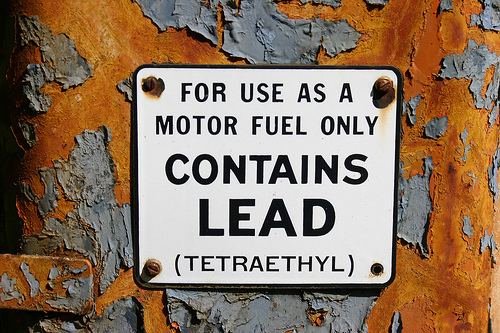
Innospec has claimed to be the last firm still making TEL, but as of 2013 TEL was apparently being produced illegally by several companies in China. As of June 2016 only Algeria, Yemen, and Iraq continue widespread use of leaded gasoline.
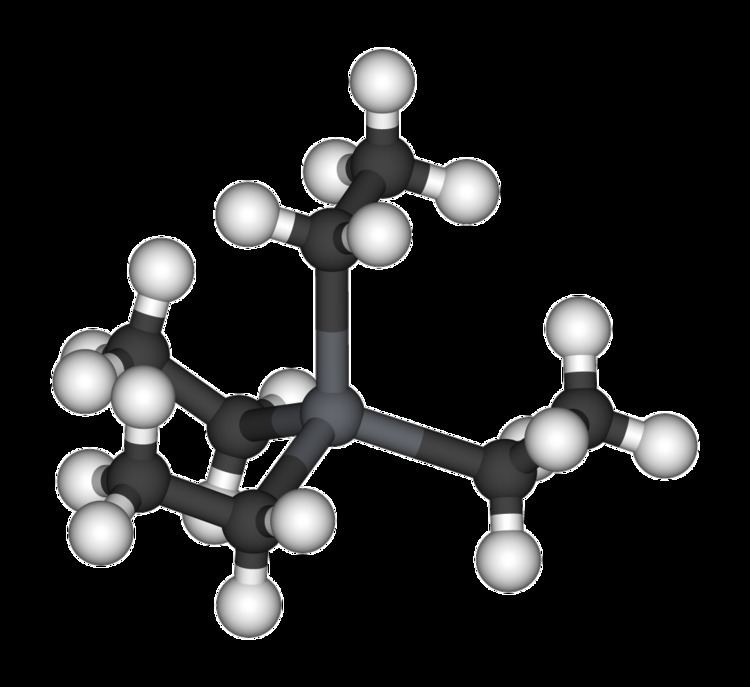
Synthesis and properties
TEL is produced by reacting chloroethane with a sodium–lead alloy.
4 NaPb + 4 CH3CH2Cl → (CH3CH2)4Pb + 4 NaCl + 3 PbTEL is also produced by reacting Ethylmagnesium Iodide with lead(II) chloride.
4C2H5Mg-I + 2PbCl2 → (C2H5)4Pb + Pb +4 MgICl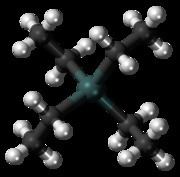
The product is recovered by steam distillation, leaving a sludge of lead and sodium chloride. TEL is a viscous colorless liquid. Because TEL is charge neutral and contains an exterior of alkyl groups, it is highly lipophilic and soluble in petrol (gasoline).

Despite decades of research, no reactions were found to improve upon this rather difficult process that involves metallic sodium and converts only 25% of the lead to TEL. A related compound, tetramethyllead, was commercially produced by a different electrolytic reaction. A process with lithium was developed, but never put into practice.
Reactions
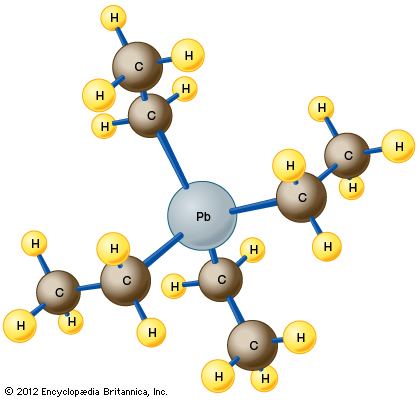
A noteworthy feature of TEL is the weakness of its four C–Pb bonds. At the temperatures found in internal combustion engines, (CH3CH2)4Pb decomposes completely into lead and lead oxides as well as combustible, short-lived ethyl radicals. Lead and lead oxide scavenge radical intermediates in combustion reactions. Engine knock is caused by a cool flame, an oscillating low-temperature combustion reaction that occurs before the proper, hot ignition. Lead quenches the pyrolysed radicals and thus kills the radical chain reaction that would sustain a cool flame, preventing it from disturbing the smooth ignition of the hot flame front. Lead itself is the reactive antiknock agent, and TEL serves as a gasoline-soluble lead carrier. When (CH3CH2)4Pb burns, it produces not only carbon dioxide and water, but also lead:
(CH3CH2)4Pb + 13 O2 → 8 CO2 + 10 H2O + PbThis lead can oxidize further to give species such as lead(II) oxide:
2 Pb + O2 → 2 PbO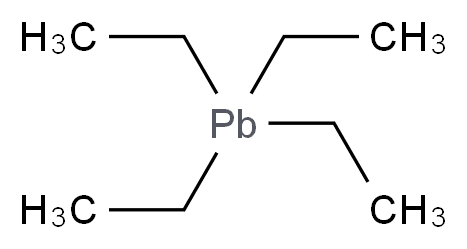
Pb and PbO would quickly over-accumulate and destroy an engine. For this reason, the lead scavengers 1,2-dibromoethane and 1,2-dichloroethane are used in conjunction with TEL—these agents form volatile lead(II) bromide and lead(II) chloride, respectively, which are flushed from the engine and into the air.
In motor fuel
TEL was extensively used as a gasoline additive beginning in the 1920s, wherein it served as an effective antiknock agent and prevented exhaust valve and valve seat wear.
Valve wear preventive
Tetraethyl lead works as a buffer against microwelds forming between the hot exhaust valves and their seats. Once these valves reopen, the microwelds pull apart and leave the valves with a rough surface that would abrade the seats, leading to valve recession. When lead began to be phased out of motor fuel, the automotive industry began specifying hardened valve seats and upgraded exhaust valve materials to prevent valve recession without lead.
Antiknock agent
A gasoline-fueled reciprocating engine requires fuel of sufficient octane rating to prevent uncontrolled combustion known as engine knocking (knock or ping). Antiknock agents allow the use of higher compression ratios for greater efficiency and peak power. Adding varying amounts of additives like low percentage TEL or high percentage ethanol to gasoline, allowed easy, inexpensive control of octane ratings. TEL offered the business advantage of being commercially profitable because it could be patented. Aviation spirits with TEL used in WWII reached 150 octane to enable supercharged engines such as the Rolls-Royce Merlin and Griffon to reach high horse power ratings at altitude. In military aviation, TEL manipulation allowed a range of different fuels to be tailored for particular flight conditions.
In 1935 the licence to produce TEL was given to I.G.Farben enabling the newly formed German Luftwaffe to use high-octane gasoline. A company, Ethyl GmbH, was formed that produced TEL at two sites in Germany with a government contract from 10 June 1936.
Phaseout and ban
In most industrialized countries, a phaseout of TEL from road vehicle fuels was completed by the early 2000s because of concerns over air and soil lead levels and the accumulative neurotoxicity of lead. The use of catalytic converters, mandated in the US for 1975 and newer model-year cars to meet tighter emissions regulations, started a gradual phase-out of leaded gasoline in the US. The need for TEL was lessened by several advances in automotive engineering and petroleum chemistry. Safer methods for making higher octane blending stocks such as reformate and iso-octane reduced the need to rely on TEL, as did other antiknock additives of varying toxicity including metallic compounds such as MMT as well as oxygenates including MTBE, TAME, and ETBE.
Lead-replacement additives were scientifically tested and some were approved by the Federation of British Historic Vehicle Clubs at the UK's Motor Industry Research Association in 1999.
In Europe, Professor Derek Bryce-Smith was among the first to highlight the potential dangers of TEL and became a leading campaigner for removal of lead additives from petrol. However, leaded motor fuel re-entered the UK market in small quantities from 2000 in response to lobbying from classic-car organisations who contended their vehicles would be rendered useless without leaded fuel. The lead content is up to 0.15 grams per litre; Bayford & Co is the only wholesale supplier.
Vehicles designed and built to run on leaded fuel may require modification to run on unleaded gasoline or autogas. These modifications fall into two categories: those required for physical compatibility with unleaded fuel, and those performed to compensate for the relatively low octane of early unleaded fuels. Physical compatibility requires the installation of hardened exhaust valves and seats. Compatibility with reduced octane was addressed by reducing compression, generally by installing thicker cylinder head gaskets and/or rebuilding the engine with compression-reducing pistons. The availability of high-octane unleaded gasoline (or LPG) has reduced or eliminated the need to decrease compression ratios.
Leaded gasoline remained legal as of late 2014 in parts of Algeria, Iraq, Yemen, Myanmar, North Korea, and Afghanistan. It was available at the pump in most of these countries as of 2011, but very little was used in North Korea and it was not clear whether it was sold in Afghanistan. Specialty chemical company Innospec says that it is the world's only manufacturer of TEL and sells it for automotive use nowhere except to Algeria as of late 2014. Innospec previously sold TEL to Iraq and Yemen as of 2011, but remains unclear after head executives were charged for bribing various government state owned oil companies, to approve the sale of their TEL products. North Korea and Myanmar buy their TEL from China. The governments of Algeria and Iraq have scheduled the final elimination of leaded gasoline in their countries in 2015, after refinery upgrades. The status in Afghanistan, Yemen, and Myanmar is unclear.
As of June 2016 UNEP-sponsored phase-out is nearly complete: only Algeria, Yemen, and Iraq continue widespread use of leaded gasoline. None use it exclusively.
Leaded-fuel bans
Leaded-fuel bans for road vehicles came into effect as follows:
Africa
Leaded petrol was supposed to be completely phased out continent-wide on 1 January 2006, following a ban initiated from the 2002 Earth Summit. However, in Algeria refineries needed to be altered; as a result, leaded fuel remains available in parts of Algeria, with phaseout scheduled for 2015.
In race vehicles
Leaded fuel was commonly used in professional auto racing, until its phase out beginning in the 1990s.
Since 1993, Formula One racing cars have been required to use normal unleaded super petrol compliant with EU standards—the same petrol provided by ordinary petrol stations.
NASCAR began experimentation in 1998 with an unleaded fuel, and in 2006 began switching the national series to unleaded fuel, completing the transition at the Fontana round in February 2007 when the premier class switched. This was influenced after blood tests of NASCAR teams revealed elevated blood lead levels.
Aviation gasoline
TEL remains an ingredient of 100 octane avgas for piston-engine aircraft. The current formulation of 100LL (low lead, blue) aviation gasoline contains 2.12 grams of TEL per gallon, half the amount of the previous 100/130 (green) octane avgas (at 4.24 grams per gallon), but only slightly less than the 2.2 grams per gallon historically permitted in automotive leaded gasoline and substantially greater than the allowed 0.001 grams per gallon in automotive unleaded gasoline sold in the United States today. The United States Environmental Protection Agency, FAA, and others are working on economically feasible replacements for leaded avgas, which still releases 100 tons of lead every year.
Alternative antiknock agents
Antiknock agents are classed as high-percentage additives, such as alcohol, and low-percentage additives based on heavy elements. Since the main problem with TEL is its lead content, many alternative additives that contain less poisonous metals have been examined. A manganese-carrying additive, methylcyclopentadienyl manganese tricarbonyl (MMT or methylcymantrene), was used for a time as an antiknock agent, though its safety is controversial and it has been the subject of bans and lawsuits. Ferrocene, an organometallic compound of iron, is also used as an antiknock agent although with some significant drawbacks.
High-percentage additives are organic compounds that do not contain metals, but require much higher blending ratios, such as 20–30% for benzene and ethanol. It had been established by 1921 that ethanol was an effective antiknock agent, but TEL was introduced instead mainly for commercial reasons. Oxygenates such as TAME derived from natural gas, MTBE made from methanol, and ethanol-derived ETBE, have largely supplanted TEL. MTBE has environmental risks of its own and there are also bans on its use.
Improvements to gasoline itself decrease the need for antiknock additives. Synthetic iso-octane and alkylate are examples of such blending stocks. Benzene and other high-octane aromatics can be also blended to raise the octane number, but they are disfavored today because of toxicity and carcinogenicity.
Formulation of ethyl fluid
TEL was supplied for mixing with raw gasoline in the form of ethyl fluid, which was TEL blended with the lead scavengers 1,2-dibromoethane and 1,2-dichloroethane. Ethyl fluid also contained a reddish dye to distinguish treated from untreated gasoline and discourage the use of leaded gasoline for other purposes such as cleaning.
In the 1920s before safety procedures were yet developed, 17 workers for the Ethyl Corporation, DuPont, and Standard Oil died from the effects of exposure to lead.
The formula for ethyl fluid is:
Dibromoethane and dichloroethane act in a synergistic manner, where a particular mixing ratio provides the best lead scavenging ability.
Toxicity
Lead pollution from engine exhaust is dispersed into the air and into the vicinity of roads and easily inhaled. Contact with concentrated TEL leads to acute lead poisoning.
Lead is a toxic metal that accumulates in the body and is associated with subtle and insidious neurotoxic effects especially at low exposure levels, such as low IQ and antisocial behavior. It has particularly harmful effects on children. These concerns eventually led to the ban on TEL in automobile gasoline in many countries. Some neurologists have speculated that the lead phaseout may have caused average IQ levels to rise by several points in the US (by reducing cumulative brain damage throughout the population, especially in the young). For the entire US population, during and after the TEL phaseout, the mean blood lead level dropped from 16 μg/dL in 1976 to only 3 μg/dL in 1991. The US Centers for Disease Control considered blood lead levels "elevated" when they were above 10 μg/dL.
Lead exposure affects the intelligence quotient (IQ) such that a blood lead level of 30 μg/dL is associated with a 6.9-point reduction of IQ, with most reduction (3.9 points) occurring below 10 μg/dL.
Reduction in the average blood lead level is believed to have been a major cause for falling violent crime rates in the United States and South Africa. Researchers including Amherst College economist Jessica Wolpaw Reyes, Department of Housing and Urban Development consultant Rick Nevin, and Howard Mielke of Tulane University, say that declining exposure to lead is responsible for up to a 56% decline in crime from 1992 to 2002. Including other factors that are believed to have increased crime rates over that period Reyes found that this led to an actual decline of 34% over that period.
A statistically significant correlation has been found between the usage rate of leaded gasoline and violent crime: taking into account a 22-year time lag, the violent crime curve virtually tracks the lead exposure curve. After the ban on TEL, blood lead levels in US children dramatically decreased.
Although leaded gasoline is largely gone in North America, it has left high concentrations of lead in the soil adjacent to roads that were constructed prior to its phaseout. Children are particularly at risk if they consume this.
History
In 1853, German chemist Karl Jacob Löwig (1803–1890) first prepared what he claimed was Pb2(C2H5)3 from ethyl iodide and an alloy of lead and sodium. In 1859, English chemist George Bowdler Buckton (1818–1905) reported what he claimed was Pb(C2H5)2 from zinc ethyl (Zn(C2H5)2) and lead(II) chloride. Later authors credit both methods of preparation with producing tetraethyl lead.
History of TEL in fuels
Regardless of the details of the chemical discoveries, tetraethyl lead remained unimportant commercially until the 1920s. In 1921, at the direction of Dupont Corporation which manufactured TEL, it was found to be an effective antiknock agent by Thomas Midgley, working under Charles Kettering at General Motors Corporation Research. General Motors patented the use of TEL as an antiknock agent and used the name "Ethyl" that had been proposed by Kettering in its marketing materials, thereby avoiding the negative connotation of the word "lead". Early research into "engine knocking" (also called "pinging" or "pinking") was also led by A.H. Gibson and Harry Ricardo in England and Thomas Boyd in the United States. The discovery that lead additives modified this behavior led to the widespread adoption of their use in the 1920s, and therefore more powerful, higher compression engines. In 1924, Standard Oil of New Jersey (ESSO/EXXON) and General Motors created the Ethyl Gasoline Corporation to produce and market TEL. Deepwater, NJ across the river from Wilmington, was the site for production of some of DuPont's most important chemicals, particularly tetraethyl lead (TEL). After TEL production at the Bayway Refinery was shut down, Deepwater was the only plant in the Western hemisphere producing TEL up to 1948, when it accounted for the bulk of the Dupont/Deepwater's production.
History of controversy and phase-out
The toxicity of concentrated TEL was recognized early on, as lead had been recognized since the 19th century as a dangerous substance that could cause lead poisoning. In 1924, a public controversy arose over the "loony gas," after at least 17 workers died, and many others were severely injured, in Standard and DuPont refineries in New Jersey. There had also been a private controversy for two years prior to this controversy; several public health experts, including Alice Hamilton and Yandell Henderson, engaged Midgley and Kettering with letters warning of the dangers to public health. After the death of the workers, dozens of newspapers reported on the issue. The New York Times editorialized in 1924 that the deaths should not interfere with the production of more powerful fuel.
To settle the issue, the U.S. Public Health Service conducted a conference in 1925, and the sales of TEL were voluntarily suspended for one year to conduct a hazard assessment. The conference was initially expected to last for several days, but reportedly the conference decided that evaluating presentations on alternative anti-knock agents was not "its province", so it lasted a single day. Kettering and Midgley stated that no alternatives for anti-knocking were available, although private memos showed discussion of such agents. One commonly discussed agent was ethanol. The Public Health Service created a committee that reviewed a government-sponsored study of workers and an Ethyl lab test, and concluded that while leaded gasoline should not be banned, it should continue to be investigated. The low concentrations present in gasoline and exhaust were not perceived as immediately dangerous. A U.S. Surgeon General committee issued a report in 1926 that concluded there was no real evidence that the sale of TEL was hazardous to human health but urged further study. In the years that followed, research was heavily funded by the lead industry; in 1943, Randolph Byers found children with lead poisoning had behavior problems, but he was threatened with a lawsuit and the research ended.
In the late 1920s, Robert A. Kehoe of the University of Cincinnati was the Ethyl Corporation's chief medical consultant and one of the lead industry's staunchest advocates, who would not be discredited until decades later by Dr. Clair Patterson's work on human lead burdens (see below) and other studies. In 1928, Dr. Kehoe expressed the opinion that there was no basis for concluding that leaded fuels posed any health threat. He convinced the Surgeon General that the dose–response relationship of lead was "no effect" below a certain threshold. As the head of Kettering Laboratories for many years, Kehoe would become a chief promoter of the safety of TEL, an influence that did not begin to wane until about the early 1960s. But by the 1970s, the general opinion of the safety of TEL would change, and by 1976 the U.S. government would begin to require the phaseout of this product.
In the late 1940s and early 1950s, Clair Cameron Patterson accidentally discovered the pollution caused by TEL in the environment while determining the age of the earth. As he attempted to measure lead content of very old rocks, and the time it took uranium to decay into lead, the readings were made inaccurate by lead in the environment that contaminated his samples. He was then forced to work in a cleanroom to keep his samples uncontaminated by environmental pollution of lead. After coming up with a fairly accurate estimate of the age of the earth, he turned to investigating the lead contamination problem by examining ice cores from countries such as Greenland. He realized that the lead contamination in the environment dated from about the time that TEL became widely used as a fuel additive in gasoline. Being aware of the health dangers posed by lead and suspicious of the pollution caused by TEL, he became one of the earliest and most effective opponents of its use.
In the 1960s, the first clinical works were published proving the toxicity of this compound in humans, e.g. by Mirosław Jan Stasik.
In the 1970s, Herbert Needleman found that higher lead levels in children were correlated with decreased school performance. Needleman was repeatedly accused of scientific misconduct by individuals within the lead industry, but he was eventually cleared by a scientific advisory council. Needleman also wrote the average US child's blood lead level was 13.7 μg/dl in 1976 and that Patterson believed that everyone was to some degree poisoned by TEL in gasoline.
In the U.S. in 1973, the United States Environmental Protection Agency issued regulations to reduce the lead content of leaded gasoline over a series of annual phases, which therefore came to be known as the "lead phasedown" program. EPA's rules were issued under section 211 of the Clean Air Act, as amended 1970. The Ethyl Corp challenged the EPA regulations in Federal court. Although the EPA's regulation was initially dismissed, the EPA won the case on appeal, so the TEL phasedown began to be implemented in 1976. Additional regulatory changes were made by EPA over the next decade (including adoption of a trading market in "lead credits" in 1982 that became the precursor of the Acid Rain Allowance Market, adopted in 1990 for SO2), but the decisive rule was issued in 1985. Then EPA mandated that lead additive be reduced by 91 percent by the end of 1986. A 1994 study had indicated that the concentration of lead in the blood of the U.S. population had dropped 78% from 1976 to 1991. The U.S. phasedown regulations also were due in great part to studies conducted by Philip J. Landrigan.
In 1995, leaded fuel accounted for only 0.6% of total gasoline sales and less than 2000 short tons (1814 t) of lead per year. From 1 January 1996, the U.S. Clean Air Act banned the sale of leaded fuel for use in on-road vehicles. Thus, what had begun in the U.S. as a phasedown ultimately ended in a phase-out. Similar bans in other countries have resulted in lowering levels of lead in people's bloodstreams.
Taking cue from the domestic programs, the U.S. Agency for International Development undertook an initiative to reduce tetraethyl lead use in other countries, notably its efforts in Egypt begun in 1995. In 1996, with the cooperation of the U.S. AID, Egypt took almost all of the lead out of its gasoline. The success in Egypt provided a model for AID efforts worldwide.
By 2000, the TEL industry had moved the major portion of their sales to developing countries whose governments they lobbied against phasing out leaded gasoline. Leaded gasoline was withdrawn entirely from the European Union market on 1 January 2000, although it had been banned much earlier in most member states. Other countries also phased out TEL. India banned leaded petrol in March 2000.
By 2011, the United Nations announced that it had been successful in phasing out leaded gasoline worldwide. "Ridding the world of leaded petrol, with the United Nations leading the effort in developing countries, has resulted in $2.4 trillion in annual benefits, 1.2 million fewer premature deaths, higher overall intelligence and 58 million fewer crimes," the United Nations Environmental Programme said. The announcement was slightly premature, as a few countries still have leaded gasoline for sale as of 2013 (see above).
